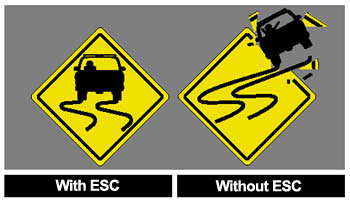The Safety of Technology

ESC saves lives.
Vehicle safety technology is one of the most rapid, progressive aspects of motor manufacturing. It has been since Nils Bohlin invented the three-point seat belt in 1959. But the most exciting developments really started happening in the last three decades thanks to improved chassis structure, increased crash test research, crumple zones, air bags, anti-lock brakes, traction control and less obvious factors such as additional brake lights and daytime running headlights.
 ESC saves lives.
ESC saves lives.
More recently, a new car offers smarter, driver-interactive safety benefits such as electronic stability control (ESC), blind spot monitoring, and lane support systems. According to the EU commissioned eSafety report, each of these technologies has potential to reduce collisions and fatalities enormously; ESC, they state, could save up to 4000 lives in Europe alone while lane support could reduce 15 per cent less deaths on European roads. With statistics like that, it’s no surprise these technologies have become standard features since the mid-90s.
Since November 2012 regulations state new cars in Europe have to promise audible safety belt alerts, rear seating must be suitably enforced to hold luggage in the boot that may be displaced during a crash. It also has to guarantee at least two ISOFIX child seat anchor points and visible warnings to not place a rear-facing child seat on any seats that face an airbag. All new vehicles must also be home to tyre pressure monitoring systems in order to reduce both blow-outs and encourage more efficient fuel economy. With the latter regulation in mind, all new car offers must include suggested gear shift indicator lights to inspire more frugal fuel efficient driving.
With these technologies now common place, engineers are now looking ahead for even more progressive safety benefits. An interesting development is that new cars now offer the option of a head-up display on the windscreen negating any instance of taking your eyes off the road. And, should the worse happen, many new vehicles also send out an SOS message to the emergency services.
Mercifully, the worse is statistically less likely to happen than ever before; in the UK alone, there was a 64 per cent reduction in traffic incident fatalities compared to statistics recorded in 1990, even though the amount of licenced vehicles on the road has increased by nearly 15 million in that time. While improved test standards and better road safety education are major influencers in these figures, vehicle safety technology has without doubt, played the largest role.
Stats sources –
www.gov.uk/government/uploads/attachment_data/file/8995/vehicles-summary.pdf
www.apccs.police.uk/APCC_Group_Emails/Road_accident_statistics.pdf







